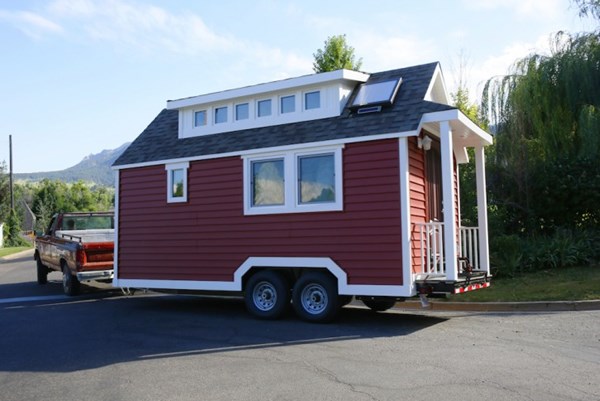TORONTO, Oct. 28, 2015 (GLOBE NEWSWIRE) -- This tiny house is making a big statement about the importance of energy efficiency for homeowners, our country, and our environment … in tiny houses and not-so-tiny houses.
While one advantage of a tiny house can be its relatively small environmental footprint, every house and homeowner can benefit from enhanced energy efficiency.
That's why Plastics Make it Possible® built this 200-square-foot house using advanced building products made possible by plastics. The multiple plastic materials such as insulation and sealants combine to create a continuous building "envelope"—the barrier between indoors and outdoors—that is tight and resists air movement, helping create a highly energy-efficient building.
And all of these plastic building materials are available right now for any size house. If plastics can help save energy in this tiny house, imagine how much energy they could save in the average Canadian house! A well-insulated house with a tight building envelope can reduce energy use and related greenhouse gas emissions, save homeowners money on energy bills, and contribute to sustainability.
Here are some of the high-performance plastics used in this tiny house, designed to leave an even tinier environmental footprint:
Spray Polyurethane Foam Insulation: This plastic foam insulation expands to fill spaces in walls and attics, sealing tough-to-reach corners and cracks, to help dramatically improve energy efficiency. Dow Building Solutions spray foam, used in this tiny house, also helps keep out dust, dirt, and insects.
Polyisocyanurate Foam Board: This stiff plastic foam board was applied to the outside of the tiny house walls (under the siding) to help prevent untreated air from even touching the wall materials/framing. Foam board insulates the house and can reduce the energy needed for heating and cooling.
Polystyrene Foam Insulation: This durable plastic foam provides an insulating barrier beneath the flooring of the tiny house, which is particularly useful here since the house is mounted to a platform on an outdoor trailer.
Solar Shingles: DOW POWERHOUSE innovative solar shingles play two roles: roof protector and renewable energy generator. The durable, engineered plastic shingles combine the aesthetic and profile of traditional shingles while eliminating the bulk and height of traditional solar panels.
Polycarbonate Skylight: Tough plastic skylight provides natural daylight, thermal resistance, and UV protection to help save energy. How tough is it? It's made from a primary material in "bullet-proof" glass: polycarbonate.
Vinyl Windows: Plastics such as vinyl have a high resistance to heat and cold, which is one reason these plastic window frames can be excellent insulators. In addition, plastic frames incorporate air gaps that help reduce the transfer of outside temperatures into the house.
Vinyl Siding and Trim: This plastic siding and trim can provide an additional barrier between indoors and out, plus they are low-maintenance, resilient, and do not need periodic painting. Vinyl siding is dent-resistant, manufactured to withstand the elements and resist fading, and can match a wide array of design aesthetics.
Polyurethane/Fiberglass Front Door: This traditional looking door from JELD-WEN is made with Covestro's tough polyurethane-based fiberglass, but it looks remarkably like wood grain. The polyurethane/fiberglass coating and plastic foam core provide an insulating barrier to heat/cold.
Plastic Sealants & Caulking: Strong yet flexible, water-resistant plastic (such as silicone) caulking and sealants help fill gaps around pipes, air ducts, plug outlets, and other places where outside air can enter a house. Plastic caulking is easy to apply, and it resists heat and moisture for a long-lasting seal.
Cross-Linked Polyethylene (PEX) Pipes: Tough but flexible PEX piping retains more heat in hot water lines than traditional piping, which can reduce energy needs. Plus PEX piping expands up to three times its diameter to resist freeze damage.
Luxury Vinyl Flooring: This upscale plastic flooring can look like wood, stone, or tile—it's soft, low maintenance, and needs no surface treatments. Luxury vinyl flooring adds a waterproof barrier layer between indoors and out.
Recycled Plastic Decking: Homeowners are relying increasingly on durable plastic composite lumber to create easily customizable decks/patios of all sizes—even tiny ones. Plastic composite decking is low maintenance, easy to clean, long lasting, and resistant to infestation and decay—and no wood splinters! Some plastic decking contains recycled plastics to prevent valuable materials from going to waste.
Foam insulation, sealants, siding, window frames, skylights, pipes, flooring, even solar shingles made with plastics! This tiny house has it all—in a tiny package that speaks louder than words about the importance of energy efficiency in our homes.
Even if you don't join the tiny home movement, it's now easier than ever to enhance energy efficiency, potentially save money on energy bills, and contribute to sustainability in our homes—with advanced plastic building materials.
Today's intelligent plastics are vital to the modern world. These materials enhance our lifestyles, our economy and the environment. For more information visit www.intelligentplastics.ca.
A photo accompanying this release is available at: http://www.globenewswire.com/newsroom/prs/?pkgid=37260
